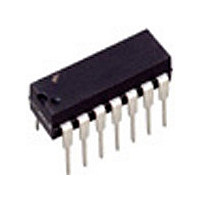FAN4822IN_NL Fairchild Semiconductor, FAN4822IN_NL Datasheet - Page 6

FAN4822IN_NL
Manufacturer Part Number
FAN4822IN_NL
Description
Manufacturer
Fairchild Semiconductor
Datasheet
1.FAN4822IN_NL.pdf
(10 pages)
Specifications of FAN4822IN_NL
Start-up Supply Current
700uA
Switching Freq
87kHz
Operating Supply Voltage (min)
12.8V
Operating Supply Voltage (typ)
13.5V
Operating Supply Voltage (max)
14.2V
Operating Temp Range
-40C to 85C
Operating Temperature Classification
Industrial
Package Type
PDIP W
Pin Count
14
Mounting
Through Hole
Lead Free Status / RoHS Status
Compliant
FAN4822
Functional Description
Switching losses of wide input voltage range PFC boost con-
verters increase dramatically as power levels increase above
200 watts. The use of zero-voltage switching (ZVS) tech-
niques improves the efficiency of high power PFCs by sig-
nificantly reducing the turn-on losses of the boost MOSFET.
ZVS is accomplished by using a second, smaller MOSFET,
together with a storage element (inductor) to convert the
turn-on losses of the boost MOSFET into useful output
power.
The basic function of the FAN4822 is to provide a power
factor corrected, regulated DC bus voltage using continuous,
average current-mode control. Like Micro Linear’s family of
PFC/PWM controllers, the FAN4822 employs leading-edge
pulse width modulation to reduce system noise and permit
frequency synchronization to a trailing edge PWM stage for
the highest possible DC bus voltage bandwidth. For minimi-
zation of switching losses, circuitry has been incorporated to
control the switching of the ZVS FET.
Theory of Operation
Figure 1 shows a simplified schematic of the output and con-
trol sections of a high power PFC circuit. Figure 2 shows the
relationship of various waveforms in the circuit. Q1 func-
tions as the main switching FET and Q2 provides the ZVS
action. During each cycle, Q2 turns on before Q1, diverting
the current in L1 away from D1 into L2. The current in L2
increases linearly until at t
When these currents are equal, L1 ceases discharging current
and is now charged through L2 and Q2. At time t
voltage of Q1 begins to fall. The shape of the voltage wave-
form is sinusoidal due to the interaction of L2 and the com-
6
V
REF
R3
22k
R4
51k
C4
330pF
R5
220
33pF
C3
2
it equals the current through L1.
R6
22k
13 V
12
7
8
V
ZV SENSE
GND
Figure 1. Simplified PFC/ZVS Schematic.
REF
C C
FAN4822
2
PWR GND
PFC OUT
ZVS OUT
, the drain
10
11
9
L1
bined parasitic capacitance of D1 and Q1 (or optional ZVS
capacitor C
low that the controller turns Q2 off and Q1 on. Q1 then
behaves as an ordinary PFC switch, storing energy in the
boost inductor L1. The energy stored in L2 is completely dis-
charged into the boost capacitor via D2 during the Q1 off-
time and the value of L2 must be selected for discontinuous-
mode operation.
Component Selection
Q1 Turn-Off
Because the FAN4822 uses leading edge modulation, the
PFC MOSFET (Q1) is always turned off at the end of each
oscillator ramp cycle. For proper operation, the internal ZVS
flip-flop must be reset every cycle during the oscillator dis-
charge time. This is done by automatically resetting the ZVS
comparator a short time after the drain voltage of the main Q
has reached zero (refer to Figure 1 sense circuit). This sense
circuit terminates the ZVS on time by sensing the main Q
drain voltage reaching zero. It is then reset by way of a resis-
tor pull-up to V
the ZVS comparator is not reset at the main Q turn off which
occurs at the end of the clock cycle. This avoids the potential
for improper reset of the internal ZVS flip-flop.
Another concern is the proper operation of the ZVS compar-
ator during discontinuous mode operation (DCM), which
will occur at the cusps of the rectified AC waveform and at
light loads. Due to the nature of the voltage seen at the drain
of the main boost Q during DCM operation, the ZVS com-
parator can be fooled into forcing the ZVS Q on for the
entire period. By adding a circuit which limits the maximum
on time of the ZVS Q, this problem can be avoided. Q3 in
Figure 1 provides this function.
Q3
Q1
R2
ZVS
C5
D1
). At t
CC
C
ZVS(OPT)
(R6). The advantage of this circuit is that
ON TIME LIMIT
Q2
3
, the voltage across Q1 is sufficiently
MAX ZVS
L2
R1
PRODUCT SPECIFICATION
C2
D2
REV. 1.0.1 8/10/01
+
C1










